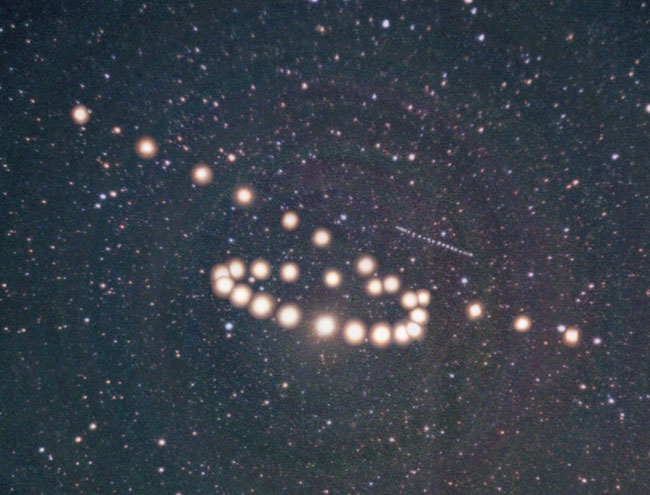Additional reading from www.astronomynotes.com
Prior to the invention of the telescope, an observer could see the following objects with the unaided eye:
- The Sun;
- The Moon;
- The five planets: Mercury, Venus, Mars, Jupiter, and Saturn;
- The stars.
If you recall from Lesson 1, we discussed that the position of the Sun in the sky appears to drift with respect to the background stars (we didn’t discuss it in depth, but the Moon also drifts with respect to the stars–this should be more obvious because we can observe it night after night!). We can’t see the stars during the day, so the Sun’s drift is not obvious to most of us. However, we know that many civilizations in the pre-telescopic era were familiar with the drift of the Sun with respect to the stars. For example, they carefully studied the heliacal risings and settings of stars and used these to mark dates on their calendars. The heliacal rising of a star is the first day it is visible just before dawn, which is a direct indication of the Sun’s drift with respect to the stars. If the Sun happens to be from our point of view in front of a particular star, say Sirius, that star will rise just before dawn only on one day of the year. The next day, Sirius will rise four minutes earlier because of the Sun’s eastward drift along the ecliptic.
Check this out...
There is more information on helical risings from Stanford on their site: "Ancient Observatories, Timeless Knowledge".
As you can see from the list in the first paragraph, there are only five planets visible to the naked eye. For these same observers, what distinguished planets from stars is, again, their motion. Planets also appear to drift compared to the background stars but in a more complicated manner than the Sun.
Test this with Starry Night!
Let's investigate two examples...
- Open up Starry Night. Set it to the following:
- location = somewhere in Pennsylvania
- date & time = May 6, 2008 @ 9:30pm
- time flow rate = 1 sidereal day
- constellation labels and stick figures turned on (if you press "k" on the keyboard, it accomplishes this for you without having to use the menu or options tab)
- Press play (or click on the forward one step button at least a dozen times), and you will watch Mars' location change with respect to the stars over the course of a few weeks or a few months.
- For the second example, open a new Starry Night session and set it to the following:
- date & time = June 6, 2003 @ 3:30am
- Otherwise, use all of the same settings as you used above.
- Again, press play or click on the forward one step button at least a dozen times. How did the path of Mars differ between the two examples?
Below is a composite image created of Mars during the 2003 time period you simulated with Starry Night:

You may want to try to avoid reading the caption at this link, though, because it gives away the punchline to this lesson.
If you study your Starry Night path of Mars or the APOD image above, you will find that the first part of Mars’ motion is prograde, or eastward compared to the stars, just like the Sun. However, around July 30, Mars has slowed down and proceeds to move retrograde, or westward compared to the stars. Then, it slows down again and begins prograde motion again! If you study the other naked-eye planets, for example, Jupiter and Saturn, you find that they exhibit the same behavior. This path is often referred to as a "retrograde loop." Again using Mars as an example, its retrograde loop is not always identical. The dates of the beginning and ending of the retrograde loop, the shape of the path of the loop with respect to the stars, and the point along the ecliptic at which the loop begins changes.
For the rest of this lesson, we are going to again study the geometry and motion of the solar system and, by the end, we will show that we can easily explain this complicated motion of Mars. While this seems simple in retrospect, it took thousands of years for scientists to determine the solution!